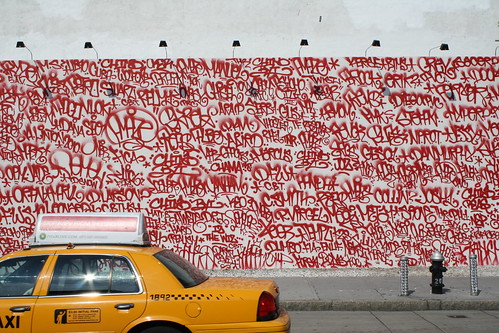Two new curators hope that the large piece of “extreme tagging” on the cement wall at Bowery and Houston will quell concerns about over-sized street art from some members of the community.
Produced by San Francisco painter and graffiti artist Barry McGee, the wall is a collage of simple but striking tags, referring by name and writing style to various intergenerational graffiti artists.
Mr. McGee’s work is the fourth formally curated project at Bowery and Houston since May 2008, and the first for the space’s new curators: 29-year-old East Village residents Kathy Grayson and Meghan Coleman, both alumni of now defunct Deitch Projects.
“Barry McGee is the ultimate smoother over,” Ms. Grayson said, explaining her hope that Mr. McGee’s mural would “smooth over the Shepard Fairey mess,” referring to the previous, controversial mural. (For a comprehensive play-by-play of destruction to the Fairey mural, which lived from April to August, see here via Bowery Boogie and here via ArtsBeat.)
The wall’s first curator, Jeffrey Deitch, worked with an art aficionado and real estate developer, Tony Goldman, who has owned the wall since 1984. In January, Mr. Deitch announced plans to close his gallery and take a position as director of the Museum of Contemporary Art in Los Angeles. Two months later, Mr. Goldman asked Ms. Coleman and Ms. Grayson to consult on the Bowery murals. “This is the crossroads of Downtown,” Mr. Goldman said. “It’s a place where millions of people a year go by. It’s like a street newspaper, and I want to be a good editor.”
Ms. Grayson was first intrigued by Mr. McGee when she saw a 40-foot mural he did in Detroit. “He’s one of the only guys to cross over from graffiti into fine art,” she said. In June, Mr. McGee did a mural in San Diego nearly identical to the Bowery wall but a negative response resulted in its removal. The new curators invited Mr. McGee to “do whatever he wanted” in the East Village.
Ms. Grayson, a director at Deitch for eight years, came to the gallery as a receptionist in 2002 after graduating from Dartmouth, and she soon began curating shows at Deitch. “I connected with a big community of artists, and that’s what’s coming with me to The Hole,” said Ms. Grayson, referring to the Goldman-hosted Soho gallery she and Ms. Coleman opened in June. “Our curatorial vision is informed by artists who make art about their lives,” Ms. Grayson said.
Ms. Coleman joined Deitch in 2003, working with the registrar prior to graduating from the New School. Quickly promoted to director of operations, Ms. Coleman oversaw production for Deitch exhibitions. “All of the really ambitious shows, Meghan figured out how to do them,” Ms. Grayson said. “She made all of their crazy ideas happen. She was the artists’ favorite person.”
Previous murals at the wall have included a recreation of Keith Haring’s iconic 1982 mural, followed in July 2009 by a mural from Brazilian graffiti-art twins Os Gemeos. The controversial Fairey mural went up in April 2010 and was the last curated by Mr. Deitch.
Prior to the curated series, Ms. Goldman says the wall was “kind of helter-skelter,” and anyone could write. “I let it go for years,” Goldman said. “It started to change as street culture in the city changed. It lessened over the years.”
Goldman calls the curated series “historical preservation” of New York City street culture. “The other corners have gentrified,” Goldman said. “I won’t give in.”
But others would disagree with Goldman’s belief that the wall has been preserved. An April post on the blog Jeremiah’s Vanishing New York — accompanied by photos of the wall pre-curation — details an opposing opinion. “While we’re enjoying these murals, it’s important to keep in mind their hidden subtext,” the post reads. “How they are, in fact, a cog in the wheel of the Big Machine that is turning the Bowery into a luxury lifestyle destination.”
Ms. Grayson would disagree. “There are a lot of walls in New York where people graffiti and wheatpaste and scribble,” she said. “Having a wall where you can bring top international artists to do a mural isn’t commercialization. It’s philanthropy.”
The wall has produced controversy since Keith Haring cleared the site in 1982. Previously a rat-and-garbage-infested handball court, Mr. Haring’s inaugural mural was defaced by other artists until he ultimately erased it.






